Submitted:
17 May 2023
Posted:
18 May 2023
You are already at the latest version
Abstract
Keywords:
1. Introduction
2. Materials and Methods
2.1. Study Area
2.2. Materials
2.3. Image Pre-Processing
2.4. Images Classification
2.4.1. Support Vector Machine
2.4.2. Maximum Likelihood
2.4.3. Minimum Distance
2.4.4. Classification Scheme and Training Data
2.4.5. Images Classification and Validation
2.4.6. Change Detection
3. Results
3.1. Classification Results
3.2. Land Cover Changes
3.3. Mined Post-Classification Comparison
4. Discussion
4.1. Accuracy Assessment
4.2. Comparing Performance of Algorithms
4.3. Assessing Land Cover Changes
5. Conclusions
Funding
Acknowledgments
Conflicts of Interest
References
- Khatami, R.; Mountrakis, G.; Stehman, S. V. A meta-analysis of remote sensing research on supervised pixel-based land-cover image classification processes: General guidelines for practitioners and future research. Remote Sens. Environ. 2016, 177, 89–100. [Google Scholar] [CrossRef]
- Lu, D.; Weng, Q. A survey of image classification methods and techniques for improving classification performance. Int. J. Remote Sens. 2007, 28, 823–870. [Google Scholar] [CrossRef]
- Ma, L.; Li, M.; Ma, X.; Cheng, L.; Du, P.; Liu, Y. A review of supervised object-based land-cover image classification. ISPRS J. Photogramm. Remote Sens. 2017, 130, 277–293. [Google Scholar] [CrossRef]
- Rogan, J.; Miller, J. Integrating GIS and remotely sensed data for mapping forest disturbance and change. In Understanding forest disturbance and spatial pattern: remote Sensing and GIS approaches; Wulder, M. A. & Franklin, S.E., Ed.; CRC Press, 2006; pp. 133–172.
- Rodriguez-Galiano, V.F.; Ghimire, B.; Rogan, J.; Chica-Olmo, M.; Rigol-Sanchez, J.P. An assessment of the effectiveness of a random forest classifier for land-cover classification. ISPRS J. Photogramm. Remote Sens. 2012, 67, 93–104. [Google Scholar] [CrossRef]
- Hall, F.G.; John, R.T.; Engman, E.T. Status of remote sensing algorithms for estimation of land surface state parameters. Remote Sens. Environ. 1995, 51, 138–156. [Google Scholar] [CrossRef]
- Huang, C.; Davis, L.S.; Townshend, J.R.G. An assessment of support vector machines for land cover classification. Int. J. Remote Sens. 2002, 23, 725–749. [Google Scholar] [CrossRef]
- Karan, S.K.; Samadder, S.R. Accuracy of land use change detection using support vector machine and maximum likelihood techniques for open-cast coal mining areas. Environ. Monit. Assess. 2016, 188. [Google Scholar] [CrossRef]
- Karan, S.K.; Samadder, S.R. A comparison of different land-use classification techniques for accurate monitoring of degraded coal-mining areas. Environ. Earth Sci. 2018, 77, 1–15. [Google Scholar] [CrossRef]
- Otukei, J.R.; Blaschke, T. Land cover change assessment using decision trees, support vector machines and maximum likelihood classification algorithms. Int. J. Appl. Earth Obs. Geoinf. 2010, 12. [Google Scholar] [CrossRef]
- Shao, Y.; Lunetta, R.S. Comparison of support vector machine, neural network, and CART algorithms for the land-cover classification using limited training data points. ISPRS J. Photogramm. Remote Sens. 2012, 70, 78–87. [Google Scholar] [CrossRef]
- Szuster, B.W.; Chen, Q.; Borger, M. A comparison of classification techniques to support land cover and land use analysis in tropical coastal zones. Appl. Geogr. 2011, 31, 525–532. [Google Scholar] [CrossRef]
- Townshend, J.R. Land cover. Int. J. Remote Sens. 1992, 13, 1319–1328. [Google Scholar] [CrossRef]
- Vorovencii, I.; Muntean, D. Evaluation of supervised classification algorithms for Landsat 5 TM images. RevCAD; J. Geod. Cadas. 2012, 11, 229–238. [Google Scholar]
- ERDAS ERDAS Field Guide; Fifth Edit.; ERDAS® , Inc.: Atlanta, 1999.
- Lillesand, T.M.; Kiefer, R.W. Remote Sensing and Image Interpretation; John Wiley and Sons Ltd.: New York, 1999. [Google Scholar]
- Mather, P.M. Computer processing of remotely sensed images: An introduction; 3rd Editio.; John Wiley and Sons Ltd., 2005. 2005.
- Richards, J.A. Remote sensing digital image analysis: An introduction; 2nd Editio.; Springer Berlin, Heidelberg, 2013; Vol. 9783642300; ISBN 9783642300622.
- Sabins, F.F. Remote sensing. Principles and interpretation; 3th Editio.; W.H. Freeman and Company: New York, 1997.
- Lawrence, R.; Bunn, A.; Powell, S.; Zambon, M. Classification of remotely sensed imagery using stochastic gradient boosting as a refinement of classification tree analysis. Remote Sens. Environ. 2004, 90, 331–336. [Google Scholar] [CrossRef]
- Pal, M.; Mather, P.M. An assessment of the effectiveness of decision tree methods for land cover classification. Remote Sens. Environ. 2003, 86, 554–565. [Google Scholar] [CrossRef]
- Adelabu, S.; Mutanga, O.; Adam, E. Evaluating the impact of red-edge band from Rapideye image for classifying insect defoliation levels. ISPRS J. Photogramm. Remote Sens. 2014, 95, 34–41. [Google Scholar] [CrossRef]
- Mitra, P.; Uma Shankar, B.; Pal, S.K. Segmentation of multispectral remote sensing images using active support vector machines. Pattern Recognit. Lett. 2004, 25, 1067–1074. [Google Scholar] [CrossRef]
- Foody, G.M. Approaches for the production and evaluation of fuzzy land cover classification from remotely sensed data. Int. J. Remote Sens. 1986, 17, 1317–1340. [Google Scholar] [CrossRef]
- Lucieer, V. Object-oriented classification of sidescan sonar for mapping benthic marine. Int. J. Remote Sens. 2008, 29, 905–921. [Google Scholar] [CrossRef]
- Hay, G.J.; Blaschke, T.; Marceau, D.J.; Bouchard, A. A comparison of three image-object methods for the multiscale analysis of landscape structure. ISPRS J. Photogramm. Remote Sens. 2003, 57, 327–345. [Google Scholar] [CrossRef]
- Pal, M. Advanced algorithms for land use and cover classification. In Advances in mapping from remote sensor imagery; Li, X.Y.& J., Ed.; CRC Press, 2012; pp. 69–90.
- Roscher, R.; Förstner, W.; Waske, B. I2VM: Incremental import vector machines. Image Vis. Comput. 2012, 30, 263–278. [Google Scholar] [CrossRef]
- Tigges, J.; Lakes, T.; Hostert, P. Urban vegetation classification: Benefits of multitemporal RapidEye satellite data. Remote Sens. Environ. 2013, 136, 66–75. [Google Scholar] [CrossRef]
- Löw, F.; Michel, U.; Dech, S.; Conrad, C. Impact of feature selection on the accuracy and spatial uncertainty of per-field crop classification using Support Vector Machines. ISPRS J. Photogramm. Remote Sens. 2013, 85, 102–119. [Google Scholar] [CrossRef]
- Ustuner, M.; Sanli, F.B.; Dixon, B. Application of support vector machines for landuse classification using high-resolution rapideye images: A sensitivity analysis. Eur. J. Remote Sens. 2015, 48, 403–422. [Google Scholar] [CrossRef]
- Lu, D.; Mausel, P.; Batistella, M.; Moran, E. Comparison of land-cover classification methods in the Brazilian Amazon basin. Photogramm. Eng. Remote Sensing 2004, 70, 723–731. [Google Scholar] [CrossRef]
- Kavzoglu, T.; Colkesen, I. A kernel functions analysis for support vector machines for land cover classification. Int. J. Appl. Earth Obs. Geoinf. 2009, 11, 352–359. [Google Scholar] [CrossRef]
- Dietterich, T.G. Approximate statistical tests for comparing supervised classification learning algorithms. Neural Comput. 1998, 10, 1895–1923. [Google Scholar] [CrossRef]
- Mantero, P.; Moser, G.; Serpico, S.B. Partially supervised classification of remote sensing images through SVM-based probability density estimation. IEEE Trans. Geosci. Remote Sens. 2005, 43, Article–559e570. [Google Scholar] [CrossRef]
- DeFries, R.S.; Chan, J.C.W. Multiple criteria for evaluating machine learning algorithms for land cover classification from satellite data. Remote Sens. Environ. 2000, 74, 503–515. [Google Scholar] [CrossRef]
- Rogan, J.; Franklin, J.; Stow, D.; Miller, J.; Woodcock, C.; Roberts, D. Mapping land-cover modifications over large areas: A comparison of machine learning algorithms. Remote Sens. Environ. 2008, 112, 2272–2283. [Google Scholar] [CrossRef]
- Demirel, N.; Emil, M.K.; Duzgun, H.S. Surface coal mine area monitoring using multi-temporal high-resolution satellite imagery. Int. J. Coal Geol. 2011, 86, 3–11. [Google Scholar] [CrossRef]
- Karan, S.K.; Samadder, S.R. Improving accuracy of long-termland-use change in coal mining areas using wavelets and Support Vector Machines. Int. J. Remote Sens. 2018, 39, 84–100. [Google Scholar] [CrossRef]
- Greșiță, C.I. Expert system used for monitoring the behaviour of hydrotechnical constructions. REVCAD J. Geod. Cadastre 2011, 11, 75–84. [Google Scholar]
- Greșiță, C.I. Surveying methods to studying the behaviour of dams (in Romanian); Tehnopress Publishing House: Iasi, 2013.
- Tudoran, G.M. Regulations regarding the management of forests included in natural protected areas. Bull. Transilv. Univ. Braşov, Ser. II For. Wood.Industry. Agric. Food Eng. 2013, 55, 35–38. [Google Scholar]
- Tudoran, G.M.; Zotta, M. Adapting the planning and management of Norway spruce forests in mountain areas of Romania to environmental conditions including climate change. Sci. Total Environ. 2020, 698, 133761. [Google Scholar] [CrossRef]
- Vorovencii, I. Changes detected in the extent of surface mining and reclamation using multitemporal Landsat imagery: a case study of Jiu Valley, Romania. Env. Monit Assess 2021, 193, 30. [Google Scholar] [CrossRef] [PubMed]
- Heumann, B.W. An object-based classification of mangroves using a hybrid decision tree-support vector machine approach. Remote Sens. 2011, 3, 2440–2460. [Google Scholar] [CrossRef]
- Vapnik, W.N.; Chervonenkis, A.Y. On the uniform convergence of the relative frequencies of events to their probabilities. Theory Probab. its Appl. 1971, 17, 264–280. [Google Scholar] [CrossRef]
- Vapnik, W.N. An overview of statistical learning theory. IEEE Trans. Neural Networks 1999, 10, 988–999. [Google Scholar] [CrossRef]
- Nyamekye, C.; Ghansah, B.; Agyapong, E.; Kwofie, S. Mapping changes in artisanal and small-scale mining (ASM) landscape using machine and deep learning algorithms. - a proxy evaluation of the 2017 ban on ASM in Ghana. Environ. Challenges 2021, 3, 100053. [Google Scholar] [CrossRef]
- Osuna, E.; Freund, R.; Girosi, F. An improved training algorithm for support vector machines. In Proceedings of the Neural Networks for Signal Processing VII. Proceedings of the 1997 IEEE Workshop; New York, 1997; pp. 276–285.
- Melgani, F.; Bruzzone, L. Classification of hyperspectral remote sensing images with support vector machines. IEEE Trans. Geosci. Remote Sens. 2004, 42, 1778–1790. [Google Scholar] [CrossRef]
- Petropoulos, G.; Partsinevelos, P.; Mitraka, Z. Change detection of surface mining activity and reclamation based on a machine learning approach of multitemporal Landsat TM imagery. Geocarto Int. 2012, 28, 323–342. [Google Scholar] [CrossRef]
- Hsu, C.W.; Chang, C.C.; Lin, C.J. A practical guide to support vector classification; Taipei, 2016.
- Weston, J.; Watkins, C. Multi-class support vector machines; London, 1998.
- Schrader, S.; Pouncey, R. Erdas field guide; 4th editio.; Erdas Inc.: Atlanta, 1997.
- Kavzoglu, T.; Reis, S. Performance analysis of maximum likelihood and artificial neural network classifiers for training sets with mixed pixels. GIScience Remote Sens. 2008, 45, 330–342. [Google Scholar] [CrossRef]
- Congalton, R.G.; Green, K. Assessing the accuracy of remotely sensed data. Principles and Practices (3th ed.); CRC Press, 2019.
- Toosi, N.B.; Soffianian, A.R.; Fakheran, S.; Pourmanafi, S.; Ginzler, C.; Waser, L.T. Comparing different classification algorithms for monitoring mangrove cover changes in southern Iran. Glob. Ecol. Conserv. 2019, 19. [Google Scholar] [CrossRef]
- Bouaziz, M.; Eisold, S.; Guermaz, E. Semiautomatic approach for land cover classification: a remote sensing study for arid climate in southeastern Tunisia. Euro-Mediterranean J. Environ. Integr. 2017, 2, Article–24. [Google Scholar] [CrossRef]
- Townsend, P.A.; Helmers, D.P.; Kingdon, C.C.; McNeil, B.E.; de Beurs, K.M.; Eshleman, K.N. Changes in the extent of surface mining and reclamation in the Central Appalachians detected using a 1976–2006 Landsat time series. Remote Sens. Environ. 2009, 113, 62–72. [Google Scholar] [CrossRef]
- Foody, G.M.; Mathur, H. A relative evaluation of multiclass image classification by Support Vector Machines. IEEE Trans. Geosci. Remote Sens. 2004, 42, 1335–1343. [Google Scholar] [CrossRef]
- Maxwell, A.E.; Warner, T.A.; Strager, M.P.; Pal, M. Combining RapidEye satellite imagery and lidar for mapping of mining and mine reclamation. Photogramm. Eng. Remote Sensing 2014, 80, 179–189. [Google Scholar] [CrossRef]
- Myint, S.W.; Gober, P.; Brazel, A.; Grossman-Clarke, S.; Weng, Q. Per-pixel vs. object-based classification of urban land cover extraction using high spatial resolution imagery. Remote Sens. Environ. 2011, 115, 1145–1161. [Google Scholar] [CrossRef]
- Xu, H.Q.; Li, P.J.; Zhang, Y.; Wang, J.F.; Coops, N.C. Urban land cover classification from very high resolution imagery using spectral and invariant moment shape information. Can. J. Remote Sens. 2010, 36, 248–260. [Google Scholar] [CrossRef]
- Foody, G.M.; Pal, M.; Rocchini, D.; Garzon-Lopez, C.X.; Bastin, L. The sensitivity of mapping methods to reference data quality: Training supervised image classifications with imperfect reference data. ISPRS Int. J. Geo-Information 2016, 5. [Google Scholar] [CrossRef]
- Pal, M.; Mather, P.M. Some issues in the classification of DAIS hyperspectral data. Int. J. Remote Sens. 2006, 105, 2895–2916. [Google Scholar] [CrossRef]
- Weston, J.; Mukherjee, S.; Chapelle, O.; Pontil, M.; Poggio, T.; Vapnik, V. MIT Open Access Articles Feature Selection for SVMs Feature Selection for SVMs. 2000.
- Fodor, D.; Lazăr, M. Ecological occupation and rehabilitation of land in the Oltenia area (in Romanian). AGIR Bull. 2006, 3, 27–31. [Google Scholar]
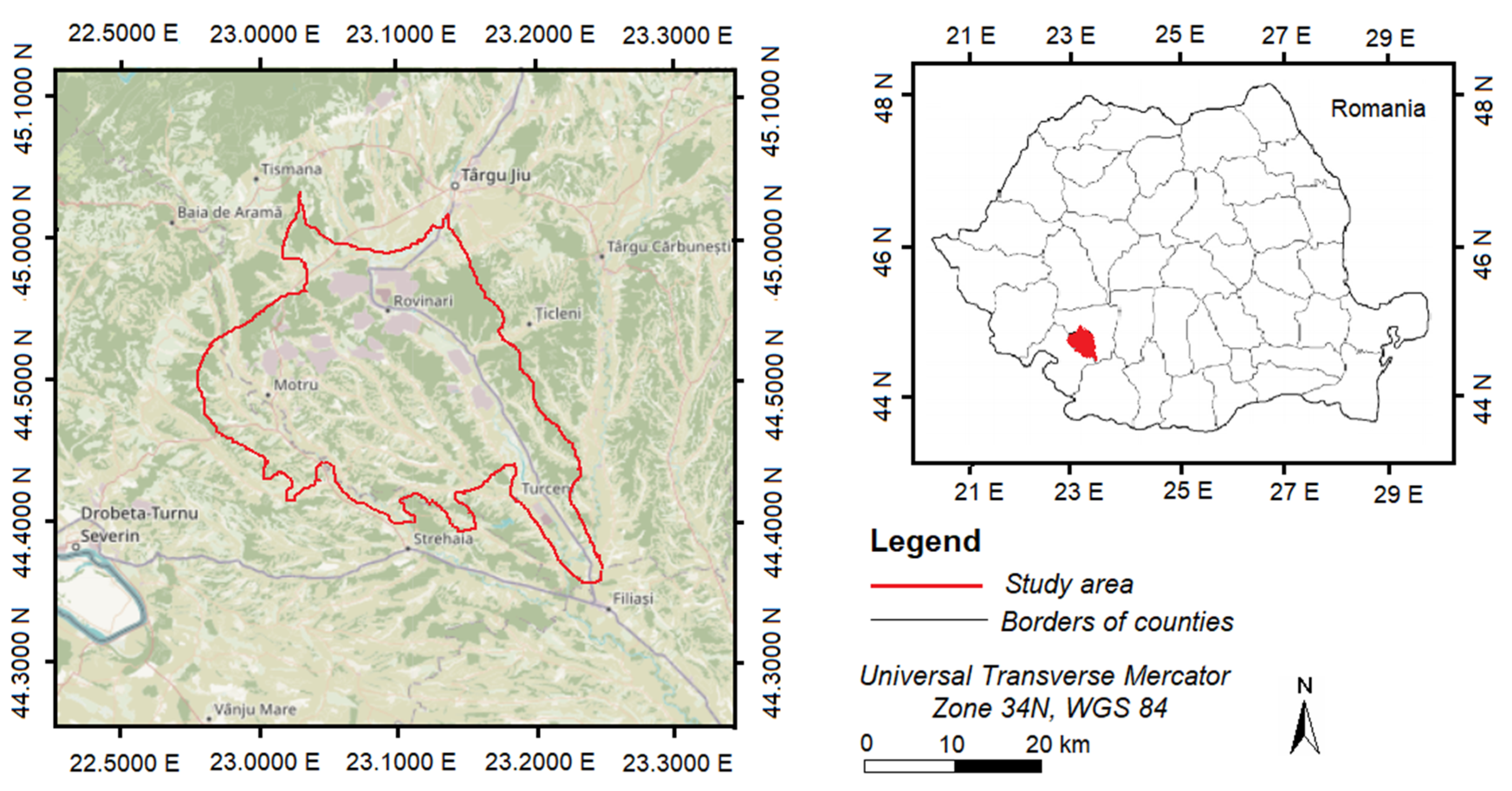
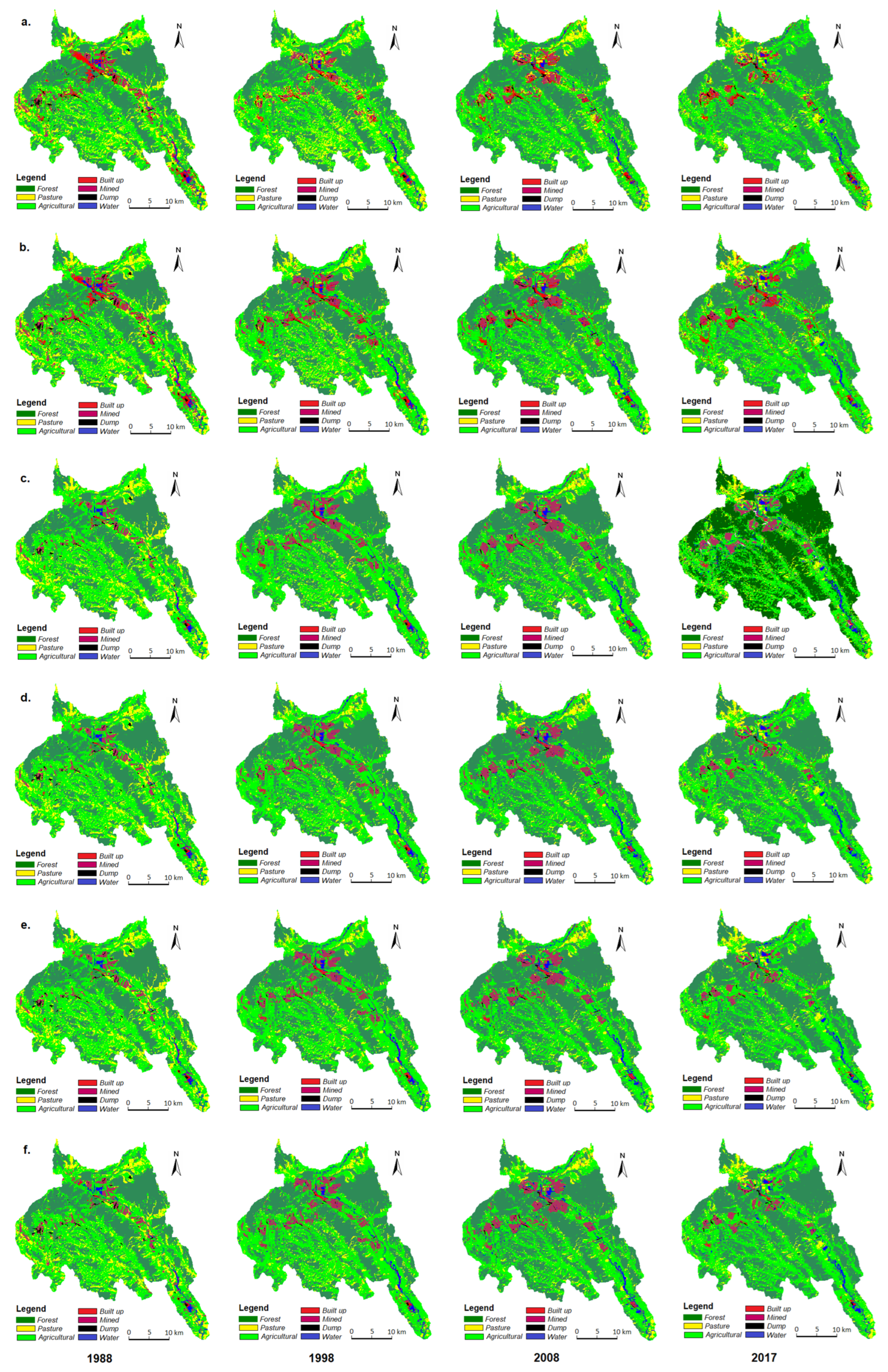
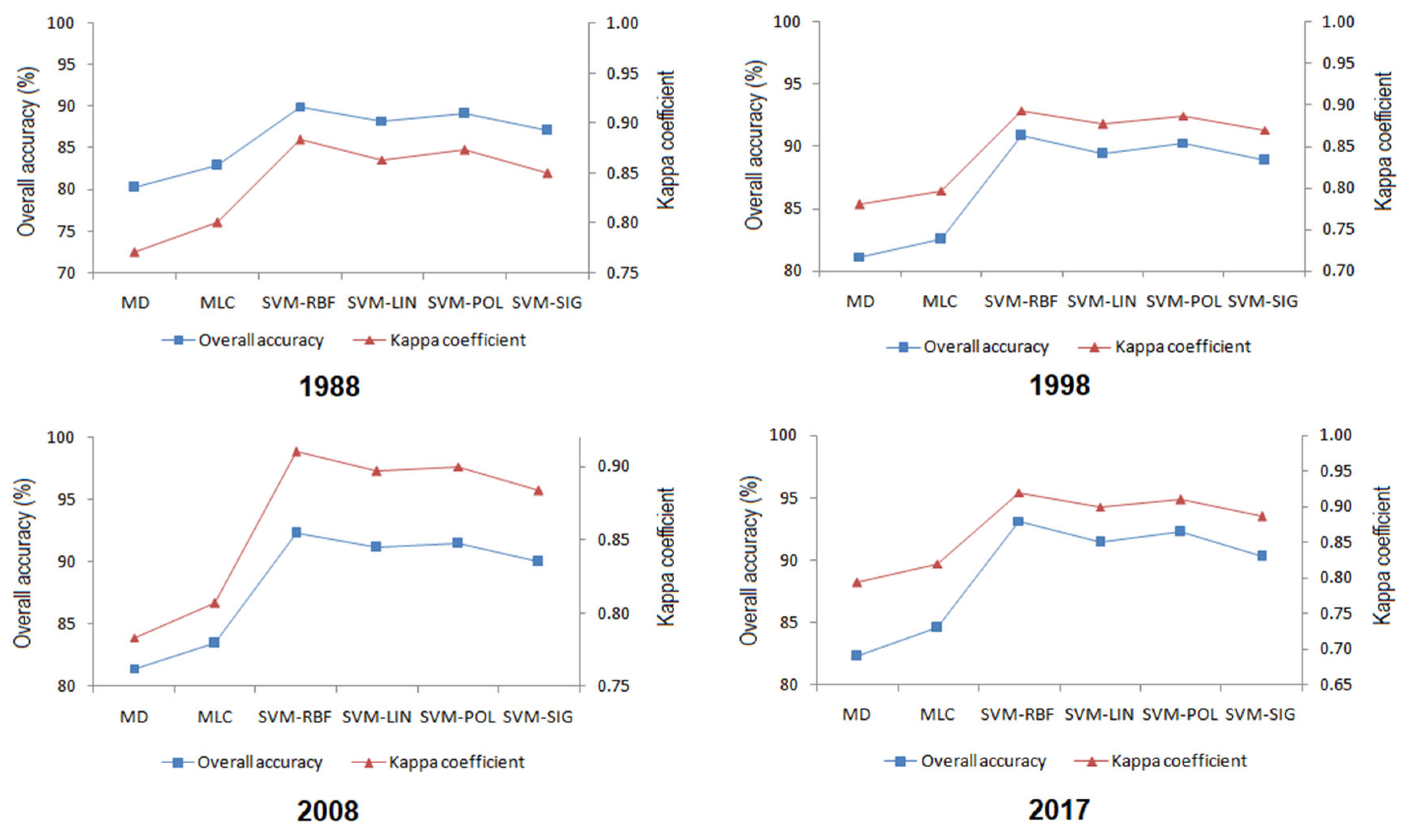
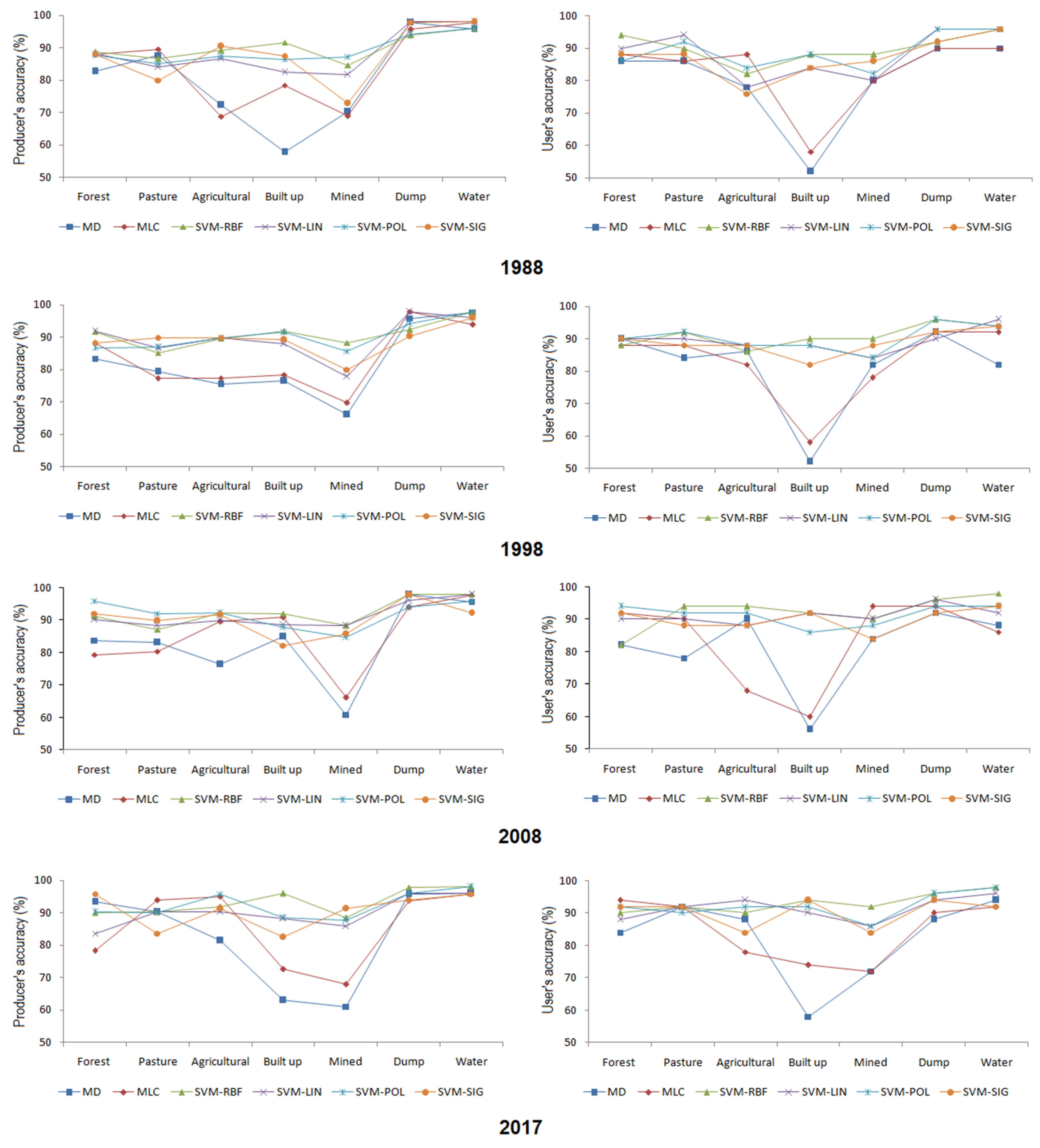
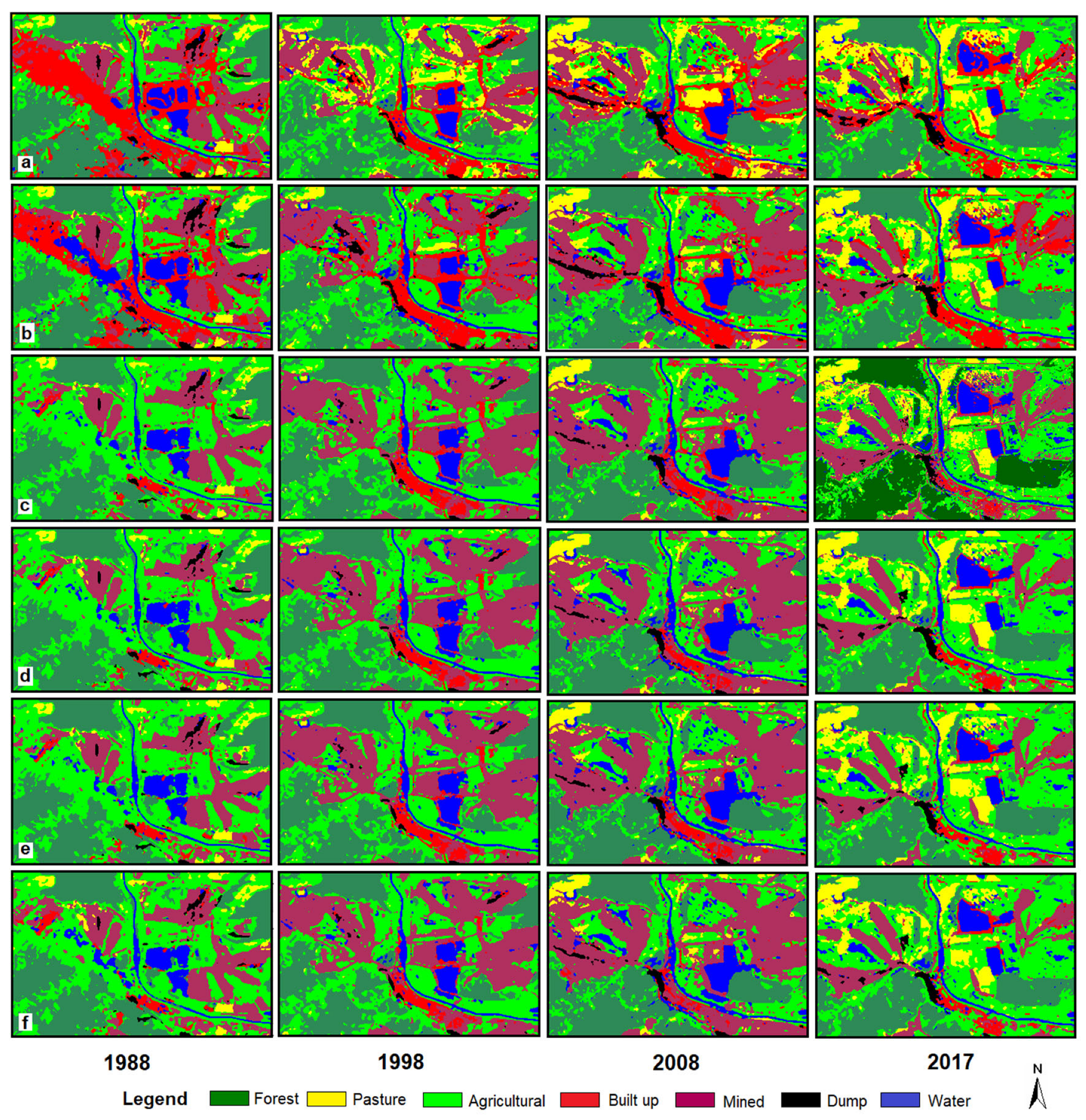
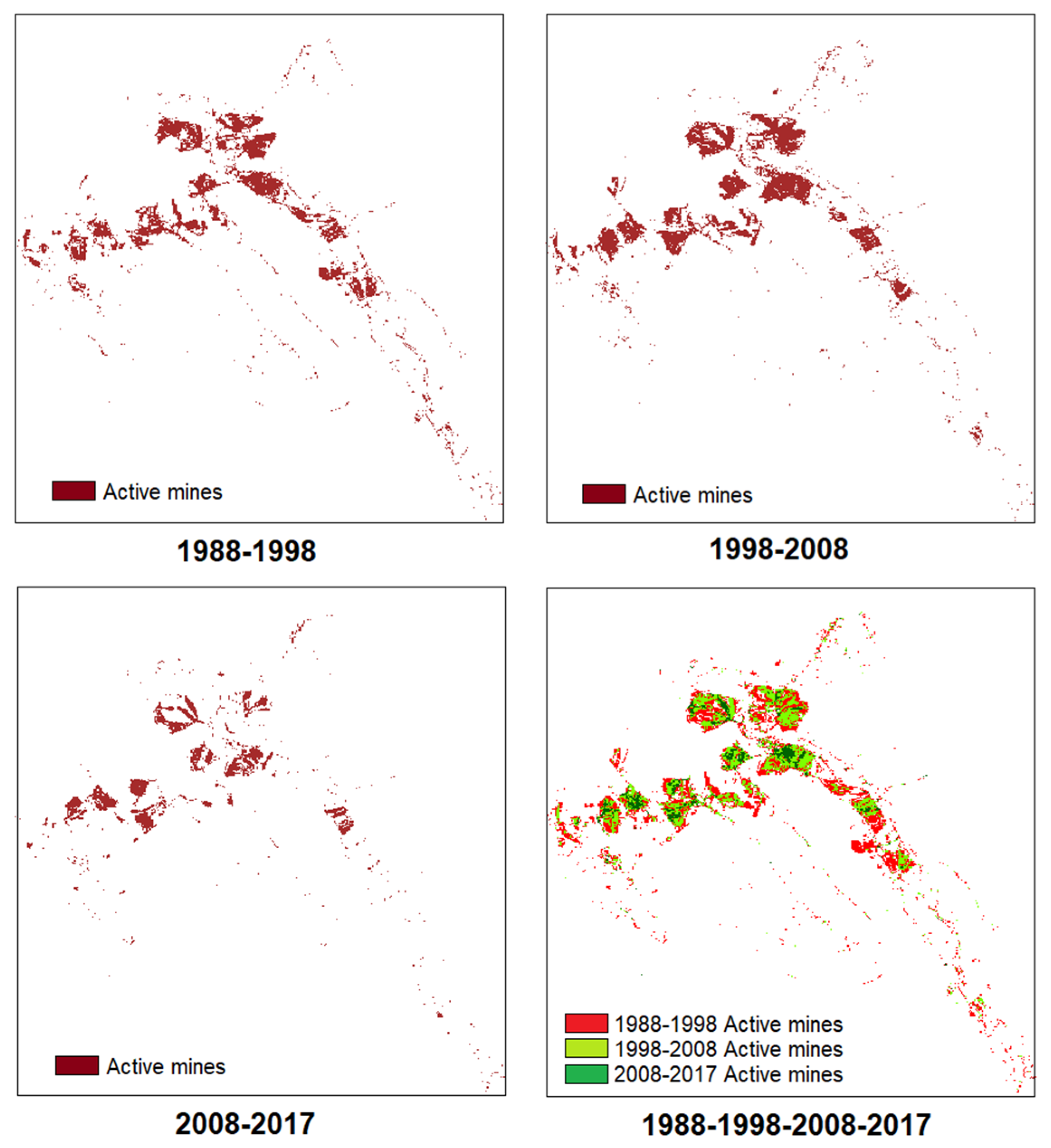
| Characteristics | Landsat 5 TM | Landsat 8 OLI |
|---|---|---|
| Acquisition date | 22 August 1988, 2 August 1998, 13 August 2008 | 16 August 2017 |
| Metadata | Yes | Yes |
| Spatial resolution (in m) | MSS30 | MSS30 |
| Spectral resolution (in μm) | Blue: (0.45–0.51) Green: (0.52–0.60) Red: (0.63–0.69) NIR: (0.76–0.90) |
Blue: (0.45–0.51) Green: (0.53–0.59) Red: (0.64–0.67) NIR: (0.85–0.88) |
| Path/row | 184/029 | 184/029 |
| Available number of bands | 7 (6 used in study: band 1–5, and 7) | 11 (6 used in study: bands 2–7) |
| No. | Kernel function | Formula | Kernel parameters | Optimal parameters used in this study |
|---|---|---|---|---|
| 1 | Linear | C | C=200 | |
| 2 | Polynomial | C, γ, r and d | C=250; γ=0.167; r=1; d=2 | |
| 3 | RBF | C and γ | C = 100; γ=0.167 | |
| 4 | Sigmoid | C, γ and r | C=100; γ=0.167; r=1; |
| Code | Land cover classes | Description |
|---|---|---|
| 1 | Forest | Evergreen forests, deciduous forests, mixed forests, shrubs (hazelnuts, willow trees, etc.) |
| 2 | Pasture | Areas consisting of arid land with short vegetation, areas with pasture and sparse grass |
| 3 | Agricultural | Areas with tall vegetation which is mown, different agricultural crops |
| 4 | Built up | Residential, commercial, industrial, parking, transportation and facilities |
| 5 | Mined (active or reclaimed) | Areas with surface mines, areas with no vegetation cover inside surface mining, areas with sparse vegetation inside surface mining (grass, shrubs, sparse forest) |
| 6 | Dump | Sterile dumps |
| 7 | Water | Rivers and lakes (natural or occurred after surface mining activity) |
| Year | Land cover class | ||||||
|---|---|---|---|---|---|---|---|
| Forest | Pasture | Agricultural | Built up | Mined | Dump | Water | |
| Pixels 1988 | 27006 | 9030 | 14029 | 1018 | 5397 | 1387 | 4093 |
| Pixels 1998 | 25299 | 4202 | 15564 | 2201 | 15536 | 1005 | 4627 |
| Pixels 2008 | 32606 | 6034 | 9959 | 1717 | 20851 | 1100 | 5415 |
| Pixels 2017 | 17046 | 5509 | 7658 | 680 | 7170 | 648 | 2596 |
| MD | ||||||||||||
| Land cover class | 1988 | 1998 | 2008 | 2017 | 1988-1998(% class) | 1998-2008 (% class) | 2008-2017 (% class) | 1988-2017 (% class) | ||||
| ha | % | ha | % | ha | % | ha | % | |||||
| Forest | 39850.2 | 37.0 | 41301.1 | 38.3 | 47285.3 | 43.9 | 53017.1 | 49.2 | 3.6 | 14.5 | 12.1 | 33.0 |
| Pasture | 14198.1 | 13.2 | 14097.2 | 13.1 | 8723.3 | 8.1 | 6741.3 | 6.3 | -0.7 | -38.1 | -22.7 | -52.5 |
| Agricultural | 42628.7 | 39.6 | 45187.0 | 42.0 | 42837.3 | 39.8 | 40832.2 | 37.9 | 6.0 | -5.2 | -4.7 | -4.2 |
| Built up | 3644.9 | 3.4 | 2430.8 | 2.3 | 3132.2 | 2.9 | 3170.4 | 2.9 | -33.3 | 28.9 | 1.2 | -13.0 |
| Mined | 5296.9 | 4.9 | 3136.9 | 2.9 | 3799.1 | 3.5 | 2006.7 | 1.9 | -40.8 | 21.1 | -47.2 | -62.1 |
| Dump | 916.2 | 0.8 | 346.9 | 0.3 | 604.0 | 0.6 | 519.1 | 0.5 | -62.1 | 74.1 | -14.1 | -43.3 |
| Water | 1180.3 | 1.1 | 1215.4 | 1.1 | 1334.1 | 1.2 | 1428.5 | 1.3 | 3.0 | 9.8 | 7.1 | 21.0 |
| Total | 107715.3 | 100 | 107715.3 | 100 | 107715.3 | 100 | 107715.3 | 100 | ||||
| MLC | ||||||||||||
| Land cover class | 1988 | 1998 | 2008 | 2017 | 1988-1998(% class) | 1998-2008 (% class) | 2008-2017 (% class) | 1988-2017 (% class) | ||||
| ha | % | ha | % | ha | % | ha | % | |||||
| Forest | 36484.6 | 33.9 | 39152.3 | 36.3 | 41502.0 | 38.5 | 42126.5 | 39.1 | 7.3 | 6.0 | 1.5 | 15.5 |
| Pasture | 14365.1 | 13.3 | 9759.3 | 9.1 | 7086.2 | 6.6 | 7077.2 | 6.6 | -32.1 | -27.4 | -0.1 | -50.7 |
| Agricultural | 45896.0 | 42.6 | 47475.7 | 44.1 | 46839.6 | 43.5 | 47694.5 | 44.2 | 3.4 | -1.3 | 1.8 | 3.9 |
| Built up | 3009.6 | 2.8 | 3347.7 | 3.1 | 3827.9 | 3.6 | 4808.3 | 4.5 | 11.2 | 14.3 | 25.6 | 59.8 |
| Mined | 5563.8 | 5.2 | 5383.3 | 5.0 | 5362.8 | 5.0 | 3464.8 | 3.2 | -3.2 | -0.4 | -35.4 | -37.7 |
| Dump | 944.9 | 0.9 | 506.2 | 0.5 | 557.4 | 0.5 | 420.8 | 0.4 | -46.4 | 10.1 | -24.5 | -55.5 |
| Water | 1451.3 | 1.3 | 2090.8 | 1.9 | 2539.4 | 2.3 | 2123.2 | 2.0 | 44.1 | 21.5 | -16.4 | 46.3 |
| Total | 107715.3 | 100 | 107715.3 | 100 | 107715.3 | 100 | 107715.3 | 100 | ||||
| SVM-RBF | ||||||||||||
| Land cover class | 1988 | 1998 | 2008 | 2017 | 1988-1998(% class) | 1998-2008 (% class) | 2008-2017 (% class) | 1988-2017 (% class) | ||||
| ha | % | ha | % | ha | % | ha | % | |||||
| Forest | 37539.6 | 34.9 | 41381.5 | 38.4 | 48369.6 | 44.9 | 48850.5 | 45.4 | 10.2 | 16.9 | 1.0 | 30.1 |
| Pasture | 13837.4 | 12.8 | 6885.7 | 6.4 | 6779.3 | 6.3 | 7233.7 | 6.7 | -50.2 | -1.5 | 6.7 | -47.7 |
| Agricultural | 50437.4 | 46.8 | 49477.5 | 45.9 | 41783.2 | 38.8 | 44535.8 | 41.3 | -1.9 | -15.6 | 6.6 | -11.7 |
| Built up | 584.8 | 0.5 | 1031.4 | 1.0 | 1206.4 | 1.1 | 1232.1 | 1.1 | 76.4 | 17.0 | 2.1 | 110.7 |
| Mined | 3534.4 | 3.3 | 7253.0 | 6.7 | 7543.7 | 7.0 | 3765.5 | 3.5 | 105.2 | 4.0 | -50.1 | 6.5 |
| Dump | 703.2 | 0.7 | 218.8 | 0.2 | 280.4 | 0.3 | 330.5 | 0.3 | -68.9 | 28.2 | 17.9 | -53.0 |
| Water | 1078.5 | 1.0 | 1467.4 | 1.4 | 1752.7 | 1.6 | 1767.2 | 1.7 | 36.1 | 19.4 | 0.8 | 63.9 |
| Total | 107715.3 | 100 | 107715.3 | 100 | 107715.3 | 100 | 107715.3 | 100 | ||||
| SVM-LIN | ||||||||||||
| Land cover class | 1988 | 1998 | 2008 | 2017 | 1988-1998(% class) | 1998-2008 (% class) | 2008-2017 (% class) | 1988-2017 (% class) | ||||
| ha | % | ha | % | ha | % | ha | % | |||||
| Forest | 38433.3 | 35.7 | 42040.4 | 39.1 | 48956.1 | 45.4 | 49663.5 | 46.1 | 9.4 | 16.5 | 1.4 | 29.2 |
| Pasture | 12878.1 | 11.9 | 5750.0 | 5.3 | 5589.0 | 5.2 | 6501.7 | 6.0 | -55.4 | -2.8 | 16.3 | -49.5 |
| Agricultural | 50171.9 | 46.6 | 49860.9 | 46.3 | 42364.8 | 39.4 | 44368.5 | 41.2 | -0.6 | -15.0 | 4.7 | -11.6 |
| Built up | 393.6 | 0.4 | 560.4 | 0.5 | 514.4 | 0.5 | 867.8 | 0.8 | 42.4 | -8.2 | 68.7 | 120.5 |
| Mined | 3830.4 | 3.6 | 7559.9 | 7.0 | 7803.0 | 7.2 | 3948.6 | 3.7 | 97.4 | 3.2 | -49.4 | 3.1 |
| Dump | 807.2 | 0.7 | 239.8 | 0.2 | 297.6 | 0.3 | 355.9 | 0.3 | -70.3 | 24.1 | 19.6 | -55.9 |
| Water | 1200.8 | 1.1 | 1703.9 | 1.6 | 2190.4 | 2.0 | 2009.3 | 1.9 | 41.9 | 28.6 | -8.3 | 67.3 |
| Total | 107715.3 | 100 | 107715.3 | 100 | 107715.3 | 100 | 107715.3 | 100 | ||||
| SVM-POL | ||||||||||||
| Land cover class | 1988 | 1998 | 2008 | 2017 | 1988-1998(% class) | 1998-2008 (% class) | 2008-2017 (% class) | 1988-2017 (% class) | ||||
| ha | % | ha | % | ha | % | ha | % | |||||
| Forest | 37914.7 | 35.2 | 42037.9 | 39.0 | 49026.1 | 45.5 | 49529.3 | 46.0 | 10.9 | 16.6 | 1.0 | 30.6 |
| Pasture | 12871.3 | 11.9 | 5748.2 | 5.3 | 5570.6 | 5.2 | 6378.8 | 5.9 | -55.3 | -3.1 | 14.5 | -50.4 |
| Agricultural | 50888.1 | 47.2 | 49972.9 | 46.4 | 42400.2 | 39.4 | 44674.8 | 41.5 | -1.8 | -15.2 | 5.4 | -12.2 |
| Built up | 397.7 | 0.4 | 686.9 | 0.6 | 695.2 | 0.6 | 849.1 | 0.8 | 72.7 | 1.2 | 22.1 | 113.5 |
| Mined | 3619.7 | 3.4 | 7344.4 | 6.8 | 7577.6 | 7.0 | 3936.2 | 3.7 | 102.9 | 3.2 | -48.1 | 8.7 |
| Dump | 814.4 | 0.8 | 244.0 | 0.3 | 296.1 | 0.3 | 346.4 | 0.3 | -70.0 | 21.4 | 17.0 | -57.5 |
| Water | 1209.4 | 1.1 | 1681.0 | 1.6 | 2149.5 | 2.0 | 2000.7 | 1.8 | 39.0 | 27.9 | -6.9 | 65.4 |
| Total | 107715.3 | 100 | 107715.3 | 100 | 107715.3 | 100 | 107715.3 | 100 | ||||
| SVM-SIG | ||||||||||||
| Land cover class | 1988 | 1998 | 2008 | 2017 | 1988-1998(% class) | 1998-2008 (% class) | 2008-2017 (% class) | 1988-2017 (% class) | ||||
| ha | % | ha | % | ha | % | ha | % | |||||
| Forest | 38896.7 | 36.1 | 41527.2 | 38.6 | 49027.8 | 45.5 | 48609.1 | 45.1 | 6.8 | 18.1 | -0.9 | 25.0 |
| Pasture | 12448.1 | 11.5 | 5882.9 | 5.5 | 5571.2 | 5.2 | 5609.9 | 5.2 | -52.7 | -5.3 | 0.7 | -54.9 |
| Agricultural | 48854.6 | 45.4 | 50359.9 | 46.7 | 42167.2 | 39.2 | 46509.7 | 43.2 | 3.1 | -16.3 | 10.3 | -4.8 |
| Built up | 372.8 | 0.3 | 443.3 | 0.4 | 348.4 | 0.3 | 644.9 | 0.6 | 18.9 | -21.4 | 85.1 | 73.0 |
| Mined | 5142.8 | 4.8 | 7605.5 | 7.1 | 8218.1 | 7.6 | 3820.1 | 3.6 | 47.9 | 8.1 | -53.5 | -25.7 |
| Dump | 809.4 | 0.8 | 242.7 | 0.2 | 316.2 | 0.3 | 364.3 | 0.3 | -70.0 | 30.3 | 15.2 | -55.0 |
| Water | 1190.9 | 1.1 | 1653.8 | 1.5 | 2066.4 | 1.9 | 2157.3 | 2.0 | 38.9 | 24.9 | 4.4 | 81.1 |
| Total | 107715.3 | 100 | 107715.3 | 100 | 107715.3 | 100 | 107715.3 | 100 | ||||
| Period 1988–1998 | ||||||||
| Forest | Pasture | Agricultural | Built up | Mined | Dump | Water | Total | |
| From mined to land cover classes: | 86.4 | 25.1 | 1366.8 | 80.2 | 1838.4 | 47.3 | 90.2 | 3534.4 |
| From land cover classes to mined: | 498.7 | 524.7 | 3834.8 | 164.4 | 1838.4 | 244.1 | 147.9 | 7253.0 |
| Overall Accuracy: 81.77% | ||||||||
| Period 1998–2008 | ||||||||
| Forest | Pasture | Agricultural | Built up | Mined | Dump | Water | Total | |
| From mined to land cover classes: | 99.2 | 207.7 | 2245.1 | 308.1 | 4088.3 | 79.6 | 79.6 | 7253.0 |
| From land cover classes to mined: | 645.0 | 49.4 | 2214.4 | 315.7 | 4088.3 | 83.6 | 147.3 | 7543.7 |
| Overall Accuracy: 83.85% | ||||||||
| Period 2008–2017 | ||||||||
| Forest | Pasture | Agricultural | Built up | Mined | Dump | Water | Total | |
| From mined to land cover classes: | 221.3 | 543.3 | 3521.6 | 471.2 | 2429.8 | 103.8 | 252.7 | 7543.7 |
| From land cover classes to mined: | 314.2 | 41.7 | 757.4 | 93.9 | 2429.8 | 34.8 | 93.7 | 3765.5 |
| Overall Accuracy: 85.95% | ||||||||
| Period 1988–2017 | ||||||||
| Forest | Pasture | Agricultural | Built up | Mined | Dump | Water | Total | |
| From mined to land cover classes: | 389.0 | 383.9 | 1867.5 | 135.4 | 502.0 | 63.5 | 193.1 | 3534.4 |
| From land cover classes to mined: | 818.0 | 296.3 | 1917.9 | 64.0 | 502.0 | 106.6 | 60.7 | 3765.5 |
| Overall Accuracy: 83.83% | ||||||||
Disclaimer/Publisher’s Note: The statements, opinions and data contained in all publications are solely those of the individual author(s) and contributor(s) and not of MDPI and/or the editor(s). MDPI and/or the editor(s) disclaim responsibility for any injury to people or property resulting from any ideas, methods, instructions or products referred to in the content. |
© 2023 by the authors. Licensee MDPI, Basel, Switzerland. This article is an open access article distributed under the terms and conditions of the Creative Commons Attribution (CC BY) license (http://creativecommons.org/licenses/by/4.0/).





